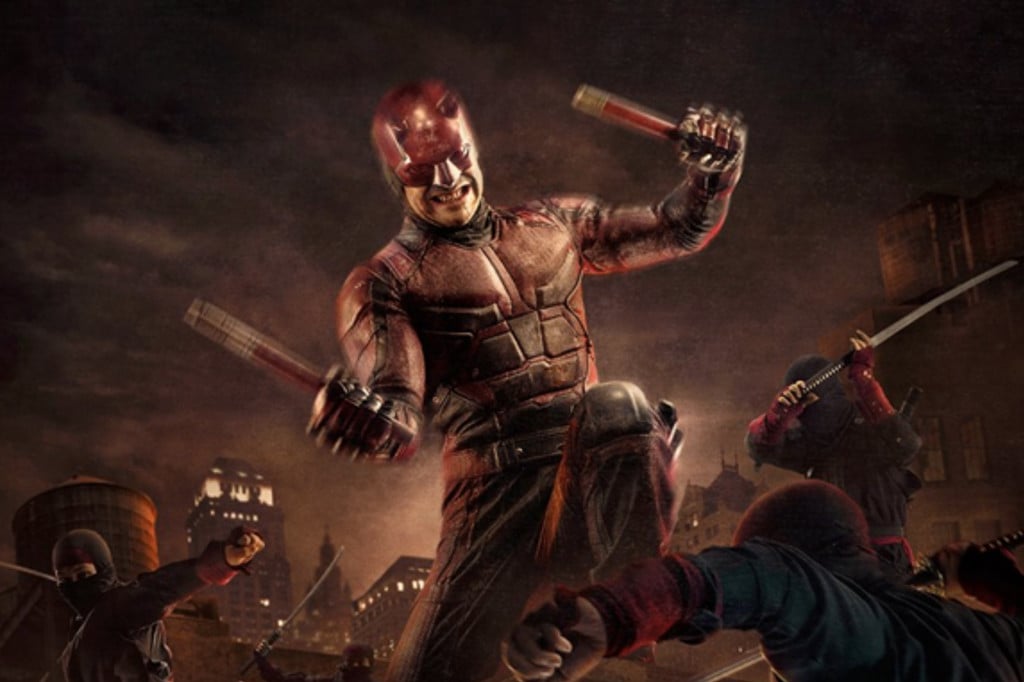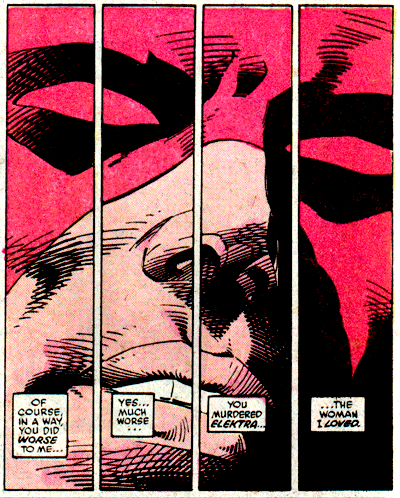Is Netflix’s Daredevil Embracing The Innate Goofiness Of The Superhero Genre?
The grittiest show on TV -- now with added spandex and rooftop ninja battles.

This piece discusses the first and second seasons of Daredevil. Spoilers!
–
“Nice duds,” Turk says sarcastically when he sees Daredevil’s new costume, revealed in the recently released second season. Even the hero’s friend Foggy calls it “underwear” and Frank Castle, AK (AKA The Punisher, his latest foe) dismisses it as “a pair of little boy pyjamas and a mask.” When Frank and Daredevil fight for the first time, The Punisher puts a bullet in the mask, and that’s an act of criticism as well. A guy who spends most of this season fighting crime in a T-shirt puts a crack in Daredevil’s mask as if he’s striking a blow against the symbol rather than the man. It’s a stand against the total ridiculousness of fighting crime in your underwear.
In long-running serial fiction like a superhero franchise, the iconic version of a character — the one that gets returned to in reboots and adaptations — isn’t necessarily the first. The original Batman fought crime in New York, not Gotham, and he did it with a gun. The first version of Superman couldn’t fly, he was just really good at jumping — “leaping tall buildings in a single bound”. They became the characters we’re familiar with later, and the same is now true of Daredevil.
–
Grit v Goof: The Dual Identity Of The Modern Superhero
The iconic Daredevil comes from a run of the comics from the early 1980s by Frank Miller, which cast him as one of the era’s “grim and gritty” loner heroes, whose stories were violent and dark. If you were a kid who grew up on superheroes, you probably went through a phase in your teens where the simple morality of the ‘good guys’ like Superman started to seem childish, and that’s who these stories appealed to. They contained the same four-colour thrills, but were dressed up with anguished monologues and bloodshed. They were basically the Christopher Nolan movies of their day.
The initial season of Netflix’s Daredevil portrayed its lead Matt Murdock in this grim and gritty style, dressed in black and committing acts of violence so brutal they made you wince. Netflix’s subsequent comic-based serial Jessica Jones was even bleaker, with a villain who was rape culture in human form and an answer to the question of whether a hero should kill or not that boiled down to: “yes, and she probably should have done it a few episodes ago”. The only time costumes and codenames came up, it was so Jessica could make fun of them.
Daredevil and Jessica Jones both focus on street-level heroes, which makes sense on a TV budget. That’s where grim and gritty storytelling works best, whereas the Marvel movies set in the same universe, with budgets big enough to make flying sequences look decent, have predominantly been much more light-hearted in their tone. Some are action movies full of one-liners, others are straight-up comedies. All of them are happy to own the kind of silly comic book elements you’d expect movies to be embarrassed about — from the Hulk’s purple pants to Guardians of the Galaxy‘s Rocket Raccoon to the enduring absurdity of every main character’s names. The moment Robert Downey Jr. said “I am Iron Man” works as both the moment he owns up to his own identity and superhero movies as a whole own up to theirs (and it’s a rad Black Sabbath reference too, obv).
–
The Appeal Of Light And Dark
Another comic book beat the Marvel movies have used is the way their antagonists act as dark mirrors of the heroes, which the second season of Daredevil is explicit about. It sets The Punisher up as a contrast to Daredevil — the black to his red. The Punisher, especially as played by Jon Bernthal, is a character so gritty he talks like he just ate your driveway. He kills without remorse, and delivers angsty monologues so long you can only get away with them on a show without ad breaks.
The contrast between the two characters is highlighted in the rooftop scene with Matt in chains that’s been a big part of the marketing for this season. It’s recreating a moment from the comics, but in the original version, when Matt is given the choice to shoot Frank and prevent him from killing, he takes it. It turns out the gun doesn’t have a firing pin and the whole thing was a philosophical experiment dreamt up by Big Pun, but in the show Matt finds another solution, one that’s heroic rather than grim.
This is followed by one of the series’ most gleefully over-the-top action sequences as Matt defeats an entire biker gang, and it begins with him pointing the empty gun at them, pulling the trigger, and then laughing at their reaction. That laugh — and the smile we see Charlie Cox flash a couple of other times when he’s in control of a fight — shows that he actually enjoys this part of being a superhero. He likes dressing like a lunatic and punching out a million goons. And just like Tony Stark at the end of the first Iron Man movie, Matt ends this season by owning up to his identity (admittedly only to one person instead of a whole press conference), and holding out that mask The Punisher tried to destroy.
In the rest of the season, we see Wilson Fisk take ownership of his Kingpin supervillain persona becoming a prison boss, Elektra gets a costume by the finale, and even the grittier-than-thou Punisher spraypaints a logo onto his chest like Goth Superman. What started as a crime show that happened to have a martial arts vigilante in it is now an unequivocal superhero story, just in time for a rooftop battle with about a million ninjas.
It’s been observed before that superhero fiction is a kind of modern myth-making and when your TV show is about a personification of justice who is literally blind because that’s how justice should be, you’re obviously dealing with something mythic. Over the course of this season — which, by the by, opens with a Catholic who dresses as a devil beating up bad guys in a church — Daredevil embraces that larger-than-life storytelling and it’s all the better for it.
Just because it’s mythic in scale (hello, immortal ninja blood cult), doesn’t mean it can’t still be a little grim around the edges when it needs to. You can have the energetic absurdity of superheroes while still dealing with the consequences of crime and violence on ordinary people and making things hard for the do-gooders, which Daredevil continues to do. Like Matt says to Foggy, it’s not really underwear: “underwear is comfortable.”
–
Daredevil‘s second season is on Netflix now.
–
